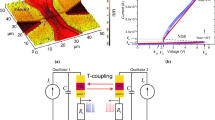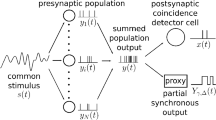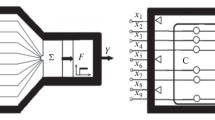Abstract
We present a biologically inspired spiking neural network which is able to detect contours in grey level images by synchronization of neurons. This network is made of integrate-and-fire neurons, spaced on a triangular network, whose oriented receptive field is constructed by a wavelet which specifically detects edges. The neurons are excitatorily and locally connected between receptive fields that tend to detect the same contour. A contour, if its width is not too large, activates a chain of neurons, with some heterogeneity in the inputs. The capacity of a chain tosync hronize with respect tosuc h heterogeneity is studied. Synchronization on a contour is found to be possible for a sufficiently large width.
Access this chapter
Tax calculation will be finalised at checkout
Purchases are for personal use only
Preview
Unable to display preview. Download preview PDF.
Similar content being viewed by others
References
Field, D. J., Hayes, A., Hess, R. F.: Contour Integration by the Human Visual System: Evidence for a Local “Association Field”. Vision Res. 33 (1992) 173–193
von der Malsburg, C.: The Correlation Theory of Brain Function. MPI Biphysical Chemistry, Internal Report 81-2. Reprinted in: Domany, E., van Hemmen, J., Schulten, K. (eds): Models of Neural Networks, Vol. 2 of Physics of Neural Networks. Springer-Verlag, New York (1994) 95–120
von der Malsburg, C., Schneider, W.: A Neural Cocktail-Party Processor. Biol. Cybern., 54 (1986) 29–40
Engel, A. K., König, P., Singer, W.: Direct Physiological Evidence for Scene Segmentation by Temporal Coding. Proc. Natl. Acad. Sci. USA 88 (1991) 9136–9140
Singer, W.: Neuronal Synchrony: a Versatile Code for the Definition of Relations? Neuron 24 (1999) 49–65
Hubel, D. H., Wiesel, T. N.: Receptive Fields, Binocular Interaction and Functionnal Architecture in the Cat’s Visual Cortex. J. Physiol. (London) 160 (1962) 106–154
Li, Z.: A Neural Model of Contour Integration in the Primary Visual Cortex. Neural Comput. 10 (1998) 903–940
Yen, S.-C., Finkel, L.: Extraction of Perceptually Salient Contours by Striate Cortical Networks. Vision Res. 38 (1998) 719–741
Yen, S.-C., Finkel, L. H.: Identification of Salient Contours in Cluttered Images. In: Computer Vision and Pattern Recognition (1997) 273–279
Choe, Y.: Perceptual Grouping in a Self-Organizing Map of Spiking Neurons. PhD thesis, Department of Computer Sciences, University of Texas, Austin. TR A101-292 (2001)
Petkov, N., Kruizinga, P.: Computational Models of Visual Neurons Specialised in the Detection of Periodic and Aperiodic Oriented Visual Stimuli: Bar and Grating Cells. Biol. Cybern. 76 (1997) 83–96
Flandrin, P.: Temps-Fréquence. Hermes, Paris, 2nd ed. (1998)
Dayan P., Abbott L. F.: Theoretical Neuroscience: Computational and Mathematical Modeling of Neural Systems. MIT Press, Cambridge (2001)
Tuckwell, H. C.: Introduction to Theoretical Neurobiology. Cambridge University Press, Cambridge (1988)
Mirollo, R. E., Strogatz, S. H.: Synchronization of Pulse-Coupled Biological Oscillators. SIAM J. Appl. Math. 50 (1990) 1645–1662
Tsodyks, M., Mitkov, I., Sompolinsky, H.: Pattern of Synchrony in Inhomogeneous Networks of Oscillators with Pulse Interactions. Phys. Rev. Lett. 71 (1993) 1280–1283
Hansel, D., Neltner, L., Mato, G., Meunier, C.: Synchrony in Heterogeneous Networks of Spiking Neurons. Neural Comput. 12 (2000) 1607–1641
Ren, L., Ermentrout, G. B.: Monotonicity of Phaselocked Solutions in Chains and Arrays of Nearest-Neighbor Coupled Oscillators. SIAM J. Math. Anal. 29 (1998) 208–234
Author information
Authors and Affiliations
Editor information
Editors and Affiliations
Rights and permissions
Copyright information
© 2002 Springer-Verlag Berlin Heidelberg
About this paper
Cite this paper
Hugues, E., Guilleux, F., Rochel, O. (2002). Contour Detection by Synchronization of Integrate-and-Fire Neurons. In: Bülthoff, H.H., Wallraven, C., Lee, SW., Poggio, T.A. (eds) Biologically Motivated Computer Vision. BMCV 2002. Lecture Notes in Computer Science, vol 2525. Springer, Berlin, Heidelberg. https://doi.org/10.1007/3-540-36181-2_6
Download citation
DOI: https://doi.org/10.1007/3-540-36181-2_6
Published:
Publisher Name: Springer, Berlin, Heidelberg
Print ISBN: 978-3-540-00174-4
Online ISBN: 978-3-540-36181-7
eBook Packages: Springer Book Archive




